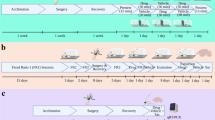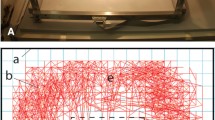Abstract
The effects of bilateral nucleus accumbens microinjections ofd-ala-met-enkephalinamide (DALA) were assessed in behavioral activation and lateral hypothalamic self-stimulation (LHSS) rate-frequency curve-shift paradigms in normal and accumbens 6-OHDA (4.0 µg) treated rats. Microinjections of DALA (2.5 µg/µl) in the behavioral activation paradigm had little effect on normal activity; however, DALA administered to 6-OHDA treated rats produced a significant overall increase in locomotion. The 6-OHDA DALA-induced locomotion effect peaked at 2 weeks after 6-OHDA treatment and then returned to baseline levels by week 5 posttreatment. Using LHSS, DALA tested over a range of doses (2.5, 5, 10, 20 µg/µl) displayed a weak biphasic reward effect only at the highest dose, which was characterized by an initial suppression followed by an elevation. DALA significantly depressed initial operant motor/performance in LHSS in a dose dependent fashion. Micro-injections of the normally ineffective low dose of DALA (2.5 µg/µl) following accumbens 6-OHDA treatment produced a significant LHSS reward decrease 2 weeks posttreatment, while LHSS motor/performance was relatively unaffected. Results are discussed in terms of opiate-dopamine and limbic-motor interactions.
Similar content being viewed by others
References
Bozarth MA, Wise RA (1981) Intracranial self-administration of morphine into the ventral tegmental area in rats. Life Sci 28:551–555
Broekkamp CLE, Phillips AG, Cools AR (1979) Facilitation of self-stimulation behavior following intracranial microinjections of opioids into the ventral tegmental area. Pharmacol Biochem Behav 11:289–295
Cador M, Taylor JR, Robbins TW (1991) Potentiation of the effects of reward-related stimuli by dopaminergic-dependent mechanisms in the nucleus accumbens. Psychopharmacology 104:377–385
Campbell KA, Evans G, Gallistel CR (1985) A microcomputer-based method for physiologically interpretable measurement of the rewarding efficacy of brain stimulation. Physiol Behav 35:395–403
Carr GD, White NM (1983) Conditioned place preference from intra-accumbens but not intra-caudate amphetamine injections. Life Sci 33:2551–2557
Castaneda E, Whishaw IQ, Robinson TE (1990) Changes in striatal dopamine neurotransmission assessed with microdialysis following recovery from a bilateral 6-OHDA lesion: variation as a function of lesion size. J Neurosci 10:1847–1854
Choulli K, Herman JP, Rivet JM, Simon H, LeMoal M (1987) Spontaneous and graft-induced behavioral recovery after 6-hydroxy-dopamine lesion of the nucleus accumbens in the rat. Brain Res 407:376–380
Chu B, Kelley AE (1992) Potentiation of reward-related responding by psychostimulant infusion into nucleus accumbens: role of dopamine receptor subtypes. Psychobiology 20:153–162
Cunningham ST, Kelley AE (1992) Opiate infusion into nucleus accumbens: contrasting effects on motor activity and responding for conditioned reward. Brain Res 588:104–114
Dauge V, Rossignol P, Roques BP (1988) Comparison of the behavioral effects induced by administration in rat nucleus accumbens or nucleus caudatus of selective mu and delta opioid peptides or kelatorphan an inhibitor of enkephalin-degrading-enzymes. Psychopharmacology 96:343–352
Dauge V, Rossignol P, Roques BP (1989) Blockade of dopamine receptors reverses the behavioral effects of endogenous enkephalins in the Nucleus caudatus but not in the nucleus accumbens: differential involvement of delta and mu opioid receptors. Psychopharmacology 99:168–175
Delfs JM, Kelley AE (1990) Microinjection of cocaine into the nucleus accumbens elicits locomotor activation in the rat. J Neurosci 10:303–310
Esposito E, Cervo L, Petrillo P, Sbacchi M, Ravani A, Samanin R (1987) Dopamine denervation of the nucleus accumbens induces a selective increase in the number of delta opioid binding sites. Brain Res 436:25–29
Ettenberg A, Duvauchelle CL (1988) Haloperidol blocks the conditioned place preference induced by rewarding brain stimulation. Behav Neurosci 102:687–691
Evans KR, Eikelboom R (1987) Feeding induced by ventricular bromocriptine and amphetamine: a possible excitatory role for dopamine in eating behavior. Behav Neurosci 101:591–593
Goeders NE, Lane JD, Smith JE (1984) Self-administration of methionone enkephalin into the nucleus accumbens. Pharmacol Biochem Behav 20:451–455
Heyman GM, Kinzie DL, Seiden LS (1986) Chlorpromazine and pimozide alter reinforcement efficancy and motor performance. Psychopharmacology 88:346–353
Hoebel BG, Monaco AP, Hernandez L, Aulisi EF, Stanley BG, Lenard L (1983) Self-injection of amphetamine directly into the brain. Psychopharmacology 81:158–163
Jenck F, Gratton A, Wise RA (1987) Opioid receptor subtypes associated with ventral tegmental facilitation of lateral hypothalamic brain stimulation reward. Brain Res 423:34–38
Koob G (1988) The functional output of the mesolimbic dopamine system. In: Kalivas P, Nemeroff C (ed) Mesocorticolimbic dopamine system. Ann NY Acad Sci, pp 216–227
Leith NJ (1982) Effects of apomorphine on self-stimulation responding: does the drug mimic current? Brain Res 277:129–136
Lenard L, Hernandez L, Hoebel BG (1980) Self-injection of amphetamine directly into the nucleus accumbens. Proc Int Un Physiol Sci 14:2217
Mucha RF, Iversen SD (1986) Increased food intake after opioid microinjection into nucleus accumbens and ventral tegmental area of rat. Brain Res 397:214–224
Paxinos G, Watson C (1986) The rat brain in stereotaxic coordinates. Academic Press, Orlando, Florida
Phillips AG, Fibiger HC (1978) The multivariate nature of motivated behavior elicited by electrical stimulation of the lateral hypothalamus. Curr Stud Hypothal Func 2:195–205
Phillips AG, LePiane FG (1982) Reward produced by microinjection ofd-ala-met-enkephalinamide into the ventral tegmental area. Behav Brain Res 5:225–229
Robinson TE, Whishaw IQ (1988) Normalization of extracellular dopamine in striatum following recovery from a partial 6-OHDA lesion of the substantia nigra: a microdialysis study in freely moving rats. Brain Res 450:209–224
Stellar JR, Corbett D (1989) Regional neuroleptic microinjections indicate a role for nucleus accumbens in lateral hypothalamic self-stimulation reward. Brain Res 477:126–143
Stellar JR, Rice M (1989) Pharmacological basis of intracranial self-stimulation reward. In: Lieberman JM, Cooper SJ (eds) Neuropharmacological basis of reward. Oxford University Press, New York, pp 14–65
Stinus L, Winnock M, Kelley AE (1985) Chronic neuroleptic treatment and mesolimbic dopamine denervation induce behavioral supersensitivity to opiates. Psychopharmacology 85:323–328
Stinus L, Nadaud D. Deminiere J, Jauregui J, Hand TT, LeMoal M (1989) Chronic flupentixol treatment potentiates the reinforcing properties of systemic heroin administration. Biol Psychiatry 26:363–371
Stricker EM, Zigmond MJ (1976) Brain catecholamines and the lateral hypothalamic syndrome. In: Novin D, Wyrwicka W, Bray GA (eds) Hunger. Basic mechanisms and clinical implications. Raven, New York, pp 19–32
Taylor JR, Robbins TW (1984) Enhanced behavioural control by conditioned reinforcers following microinjections ofd-amphetamine into the nucleus accumbens. Psychopharmacology 84:405–412
Taylor JR, Robbins TW (1986) 6-Hydroxydopamine lesions of the nucleus accumbens, but not of the caudate nucleus, attenuate enhanced responding with reward-related stimuli produced by intra-accumbensd-amphetamine. Psychopharmacology 90:390–397
VanDerKooy D, Mucha RF, O'Shaughnessy M, Bucenieks P (1982) Reinforcing effects of brain microinjections of morphine revealed by conditioned place preference. Brain Res 243:107–117
West TEG, Wise RA (1989) Nucleus accumbens injections of mu and delta but not kappa opioids facilitate hypothalamic brain stimulation reward. Soc Neurosci Abstr 20. 8:34
White NM, Packard MG, Hiroi N (1991) Place conditioning with dopamine D1 and D2 agonists injected peripherally or into the nucleus accumbens. Psychopharmacology 103:271–276
Wise RA (1988) Psychomotor stimulant properties of addictive drugs. Ann NY Acad Sci 537:228–234
Author information
Authors and Affiliations
Rights and permissions
About this article
Cite this article
Johnson, P.I., Stellar, J.R. Effects of accumbens DALA microinjections on brain stimulation reward and behavioral activation in intact and 6-OHDA treated rats. Psychopharmacology 114, 665–671 (1994). https://doi.org/10.1007/BF02244999
Received:
Revised:
Issue Date:
DOI: https://doi.org/10.1007/BF02244999




